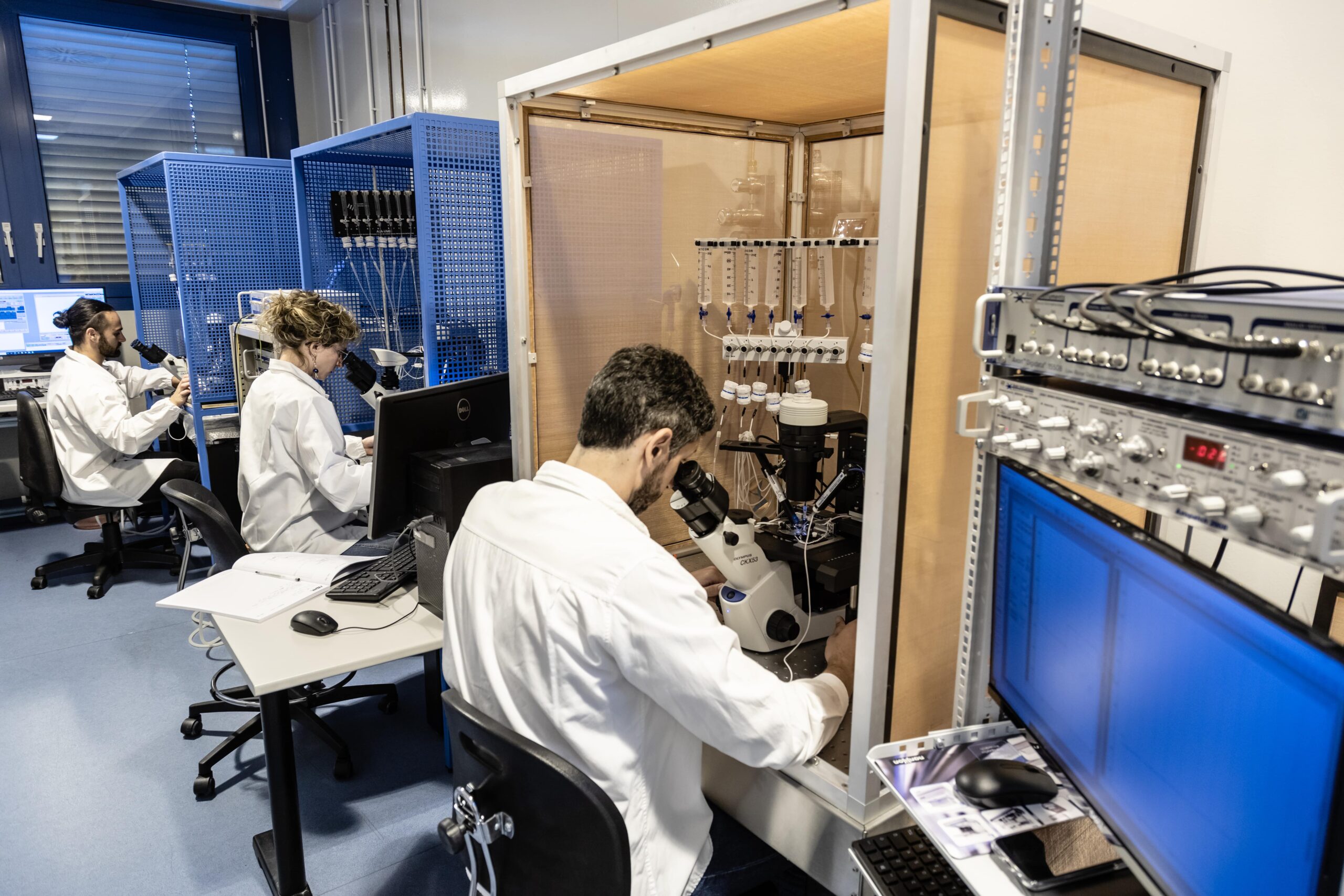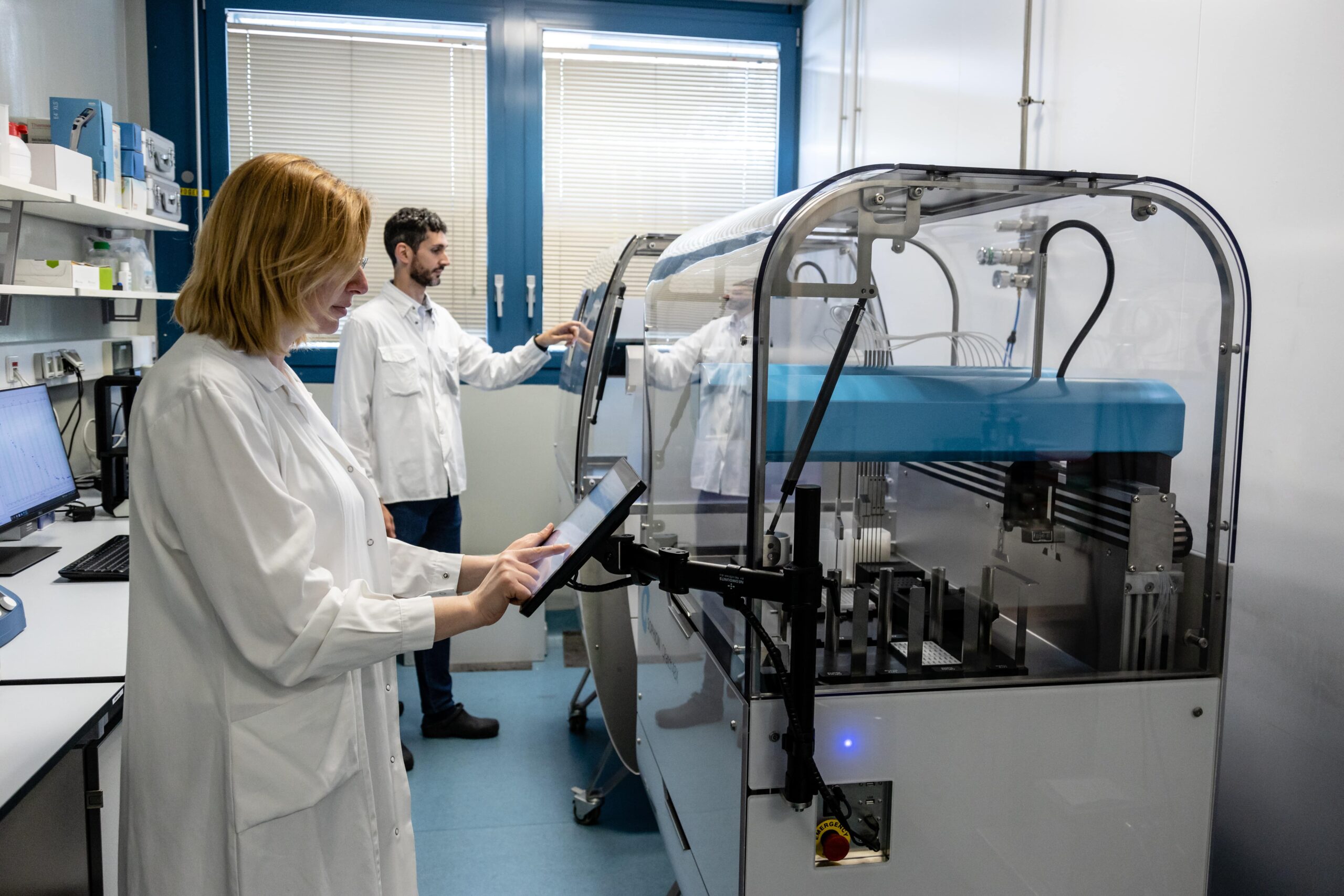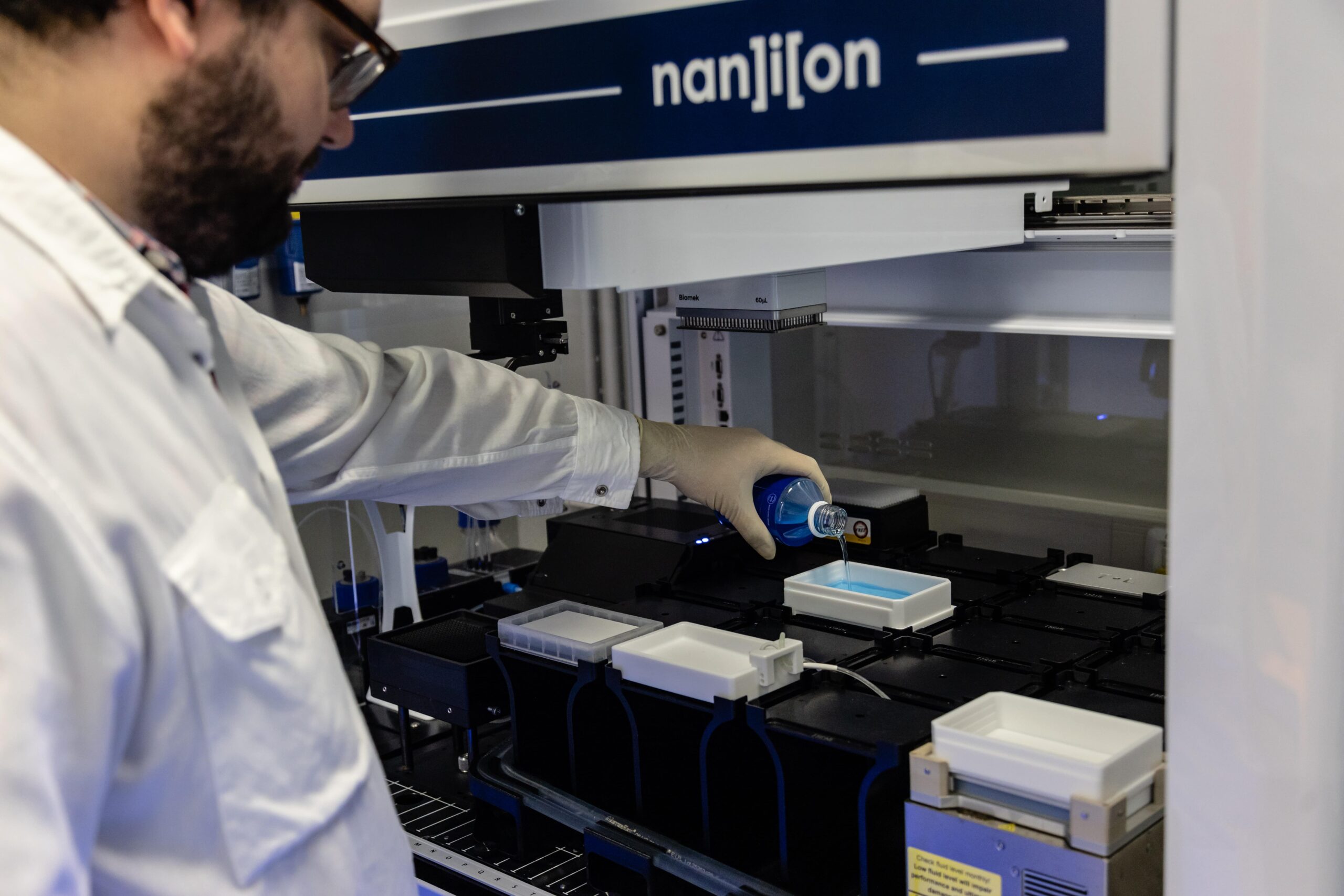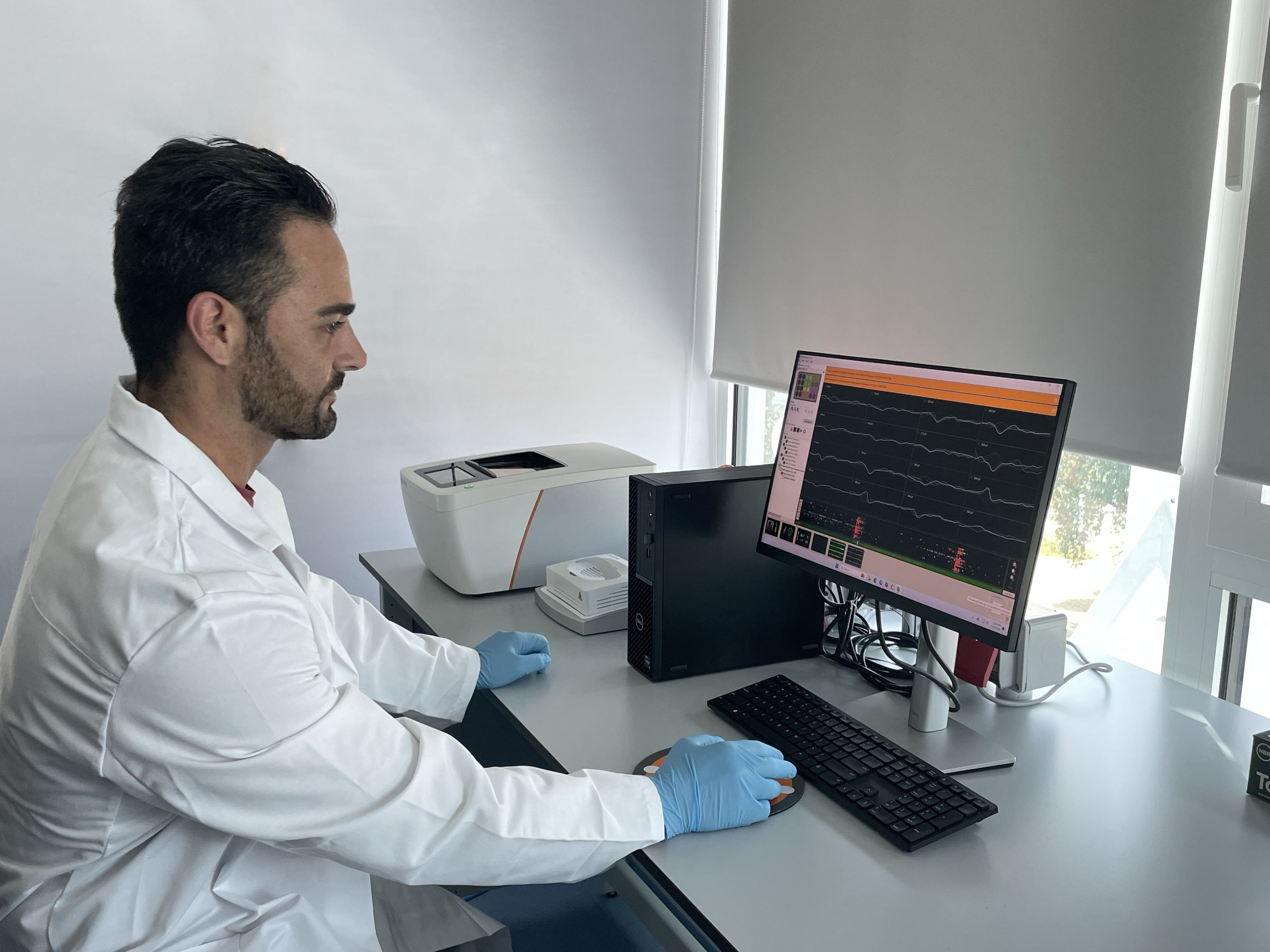Electrophysiology
Electrophysiology, the study of electrical properties in biological cells and tissues, has become a cornerstone in early drug discovery, offering unparalleled insights into the mechanisms of drug action and toxicity. By leveraging techniques such as patch-clamp recording and high-throughput screening, researchers can assess the impact of novel compounds on ion channels, receptors, and cellular excitability with high precision. This not only accelerates the identification of potential therapeutic candidates but also enhances the safety profile of drugs by detecting adverse electrophysiological effects early in the development process. As a result, electrophysiology is integral to optimizing the efficacy and safety of new pharmacological interventions.
Your channel, our solution
Our team of skilled electrophysiologists is equipped with a diverse array of advanced devices, enabling us to tailor our approach to meet your specific research needs. We offer comprehensive strategies for studying:
- Ion channels on isolated cells, providing detailed insights into individual channel behavior.
- Ion channels on organellar membranes, allowing for the investigation of subcellular electrophysiological processes.
- Electrical activity in populations of cells, facilitating the analysis of collective cellular responses and interactions.
This flexibility ensures precise and relevant data to support your early drug discovery efforts.
Our patch clamp platforms
The patch-clamp technique is a cutting-edge method used in electrophysiology to study the electrical properties of individual ion channels in cells. It provides precise measurements of ionic currents, allowing scientists to explore the function and regulation of these channels with unparalleled accuracy. This technique is invaluable in drug development, neuroscience, and cardiology, offering deep insights into cellular functions and enabling the discovery of new therapeutic targets. Whether you’re investigating the basic science of cellular processes or developing innovative treatments, patch-clamp is an essential tool for groundbreaking research.
During the assay development phase, our platforms allow us to validate pharmacologically and biophysically “in house generated” or transferred cell lines. Then, using the most suitable tools, we design fine-tuned experimental conditions to perform small and medium-scale compound testing and primary screenings, as well as hit validation experiments and mode of action studies on ligand- and voltage-gated ion channels using the proper configuration (cell attached, whole-cell, inside-out or outside-out).



- Whole cell or single channel (inside- and outside-out configurations) recordings
- Cellular and organellar electrophysiology
- Low throughput compound profiling & mode-of-action studies
- Optogenetics
- iPSC-derived cell electrophysiology (temperature control)
- Fast internal (Port-a-Patch) and external solution exchange
- Medium-high throughput screening for hit discovery, hit confirmation and SAR campaign
- On off-the-shelf assays or adapted clients’ assays
- Preliminary cardiac safety profiling
- Suitable for iPSC-derived cell electrophysiology
- Current clamp and temperature control available
- Implemented for Genedata analysis settings
- Fully automated high throughput screening for hit discovery, hit confirmation and SAR campaign
- On tailored-made assays or adapted clients’ assays
- Suitable for clone selection during cell line generation
- Fast internal solution exchange
- iPSC-derived cell electrophysiology
- Current clamp and temperature control available
- Optogenetics (opto-SyncroPatch)
- Implemented for Genedata analysis settings
- Automated LysoPatch (worldwide premiere)
Our MEA platform
Multi-electrode array (MEA) systems are widely used in electrophysiological research to study electrically active cells, such as neural networks and cardiac syncytium. These systems measure field potentials across large populations of cells, providing significantly more data points per well and detecting network activity pattern that classic patch clamp electrophysiology would miss. MEA electrophysiology employs arrays of tiny electrodes at the bottom of multi-well plates or single wells (chips) to explore electrochemical changes in cells.

Electroactive cells, such as neurons or cardiomyocytes, can be cultured on these electrodes to form cohesive networks, allowing researchers to capture functional behavior and identify electrical activity, whether spontaneous or induced. MEA also provide information on non electrically active cells, taking advantage of impedence measures that allows for example to monitor muscle cells contractions or in general cell viability. Wide spectrum analysis (0-100Hz) allows us to monitor slower frequency network oscillations which are often altered in many neurological diseases.
MEA systems are crucial for understanding the electrophysiological function of neuronal network providing temporally detailed information without disturbing the cell membrane or requiring voltage-dependent dyes. In the cardiac syncytium it allows to monitor cardiac rhythm and conduction velocity alterations.
This technology is particularly important for studying diseases associated with alterations in electrical activity, such as epilepsy, neurodegenerative disorder or cardiac arrhythmias. The Maestro Pro MEA platform (Axion BioSystems, USA) is used at Axxam for:
- Highlight alteration in neuronal network connectivity in real time
- Neurodegeneration studies
- Drug discovery for neuroactive compounds
- Investigate susceptibility to seizure like events and screening for anticonvulsant drugs
- Investigate myocyte and cardiomyocyte excitation contraction coupling
- Cardiotoxicity studies (field potentials, propagation, and contractility)
- Screening for molecule able to modulate cardiac action potentials (Local Extracellular Action Potentials)
- Cutting-edge optical assay techniques, such as optogenetics
Off-the-shelf assays
Axxam has already validated several assays that can immediately been used for services and additional assays can be adapt upon client’s request.
Interested in going deeper into the cell?
In the last few years, we have developed a huge expertise on organellar electrophysiology enabling the study of ion channels localized on the membrane of nuclei (manual NucleoPatch), lysosomes (LysoPatch and automated LysoPatch) and mitochondria (manual MitoPatch).
Related Content
Voltage-gated ion channels
Parallel all-optical assay to study use-dependent functioning of voltage-gated ion channels in a miniaturized format (SLAS Discov. 2021 Mar;26(3):460-469. doi: 10.1177/2472555220976083)
Ligand-gated ion channels
A new electro-optical approach for conductance measurement: an assay for the study of drugs acting on ligand-gated ion channels (Sci Rep. 2017 Mar 21:7:44843. doi: 10.1038/srep44843)
Solute carriers
An overview of cell-based assay platforms for the solute carrier family of transporters (Front Pharmacol. 2021 Aug 10:12:722889. doi: 10.3389/fphar.2021.722889. eCollection 2021)
NucleoPatch
Identifying ryanodine receptor modulators: from high-throughput screening to single channel recording (download poster)
Potassium channel
A potassium channel agonist protects hearing function and promotes outer hair cell survival in a mouse model for age-related hearing loss (Cell Death Dis. 2022 Jul 11;13(7):595. doi: 10.1038/s41419-022-04915-5)
